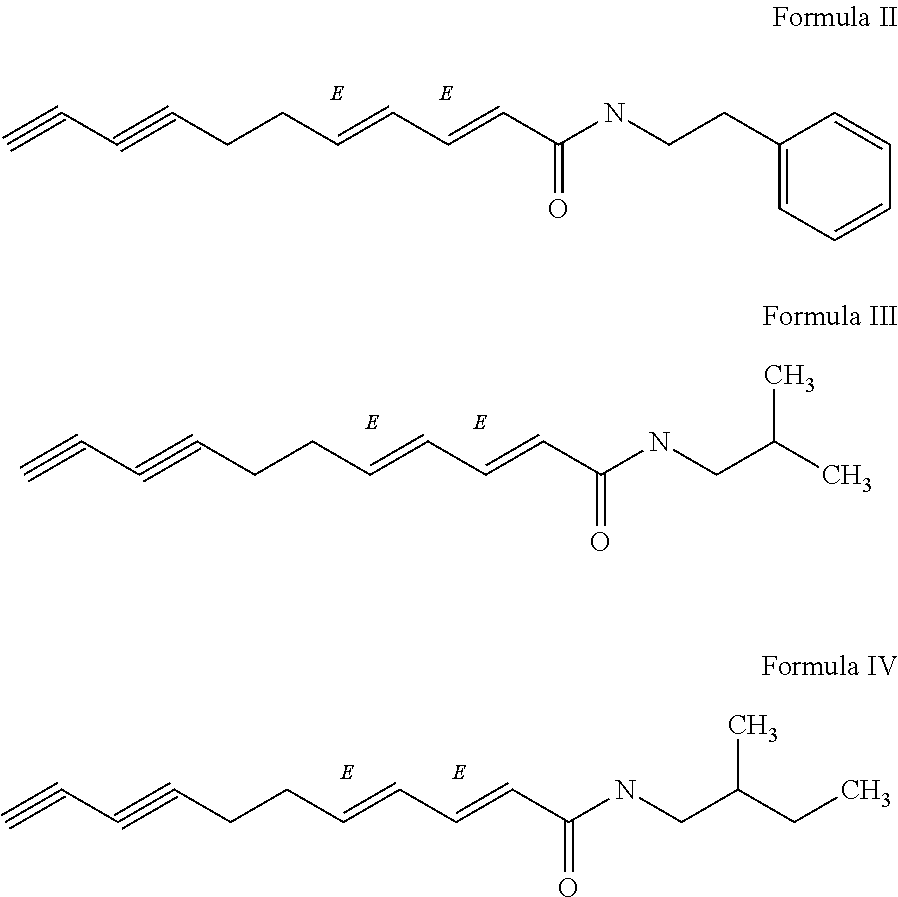Flavor-enhancing amide compounds
a technology of amide compounds and flavor enhancement, applied in the field of flavor enhancement, can solve the problems of bitter taste, menthol also exhibits undesirable properties, adverse effects as well as allergic reactions in humans, etc., and achieve the effect of enriching, imparting or enhancing tas
- Summary
- Abstract
- Description
- Claims
- Application Information
AI Technical Summary
Benefits of technology
Problems solved by technology
Method used
Image
Examples
example i
[0036]
[0037]Preparation of 5-Iodopent-4-yn-1-ol: Potassium hydroxide (115 g, 2.051 mol, commercially available from Sigma-Aldrich, Inc.) was dissolved in water (150 ml) and cooled to 0° C. Pent-4-yn-1-ol (69 g, 820 mmol, commercially available from Sigma-Aldrich, Inc.) was dissolved in methanol (1.125 L) and slowly added to the reaction mixture while maintaining the temperature at 0° C. After 15-30 minutes, iodine (229 g, 902 mmol) was added in one portion and the mixture was warmed to room temperature and stirred for 3 hours. The mixture was then diluted with water (750 mL) and washed three times with diethyl ether (Et2O, 300 mL). The organic layers were combined and concentrated in vacuo to provide a yellow oil. The oil was dissolved in methylene chloride (CH2Cl2) (300 mL), washed with brine (300 mL), dried with sodium sulfate (Na2SO4), and filtered. The solvent was then removed in vacuo to provide the crude product (170 g), which was purified by column chromatography with hexane:...
example ii
[0039]
[0040]Preparation of 7-(Trimethylsilyl)hepta-4,6-diyn-1-ol: Ethynyltrimethylsilane (112 g, 1.143 mol, commercially available from Sigma-Aldrich, Inc.), piperidine (847 ml, 8.571 mol, commercially available from Sigma-Aldrich, Inc.), and 5-iodopent-4-yn-1-ol (120 g, 0.571 mol, prepared as above) were combined and cooled to 0° C. Copper(I) chloride (5.66 g, 57.1 mmol, commercially available from Sigma-Aldrich, Inc.) was added in one portion. The reaction mixture was stirred with gradual warming to room temperature. After 30 minutes, the solution was quenched with saturated ammonium chloride solution (NH4Cl) (2.5 L) and washed three times with Et2O (300 mL). The organic layers were combined, washed twice with brine (500 mL), dried with Na2SO4, filtered, and concentrated in vacuo using a rotary evaporator. The crude product was purified by silica gel chromatography (Hex:EtOAc 6:1) to provide 7-(trimethylsilyl)hepta-4,6-diyn-1-ol (91.8 g, 86% yield).
[0041]1H NMR (500 MHz, CDCl3) δ:...
example iii
[0042]
[0043]Preparation of 7-(Trimethylsilyl)hepta-4,6-diynal: Dimethyl sulfoxide (DMSO) (76 ml, 1.076 mol) was added dropwise at −78° C. to a solution of oxalyl chloride (47.1 ml, 538 mmol, commercially available from Sigma-Aldrich, Inc.) in CH2Cl2 (750 ml). The reaction mixture was stirred for 20 minutes at −78° C. 7-(Trimethylsilyl)hepta-4,6-diyn-1-ol (50 g, 269 mmol, prepared as above) was dissolved in CH2Cl2 (15 mL) and slowly added. The reaction mixture was stirred for 1 hour at −78° C. Triethylamine (225 ml, 1.614 mol, commercially available from Sigma-Aldrich, Inc.) was then added. The reaction mixture was further stirred for 80 minutes while slowly warming to room temperature. The reaction mixture was quenched with saturated NH4Cl, separated, and the aqueous portion was back-extracted twice with CH2Cl2 (200 mL). The organic layers were combined, dried with Na2SO4, filtered, and concentrated in vacuo. The crude was purified by column chromatography (Hex:EtOAc) to provide 7-(...
PUM
| Property | Measurement | Unit |
|---|---|---|
| Fraction | aaaaa | aaaaa |
| Percent by mass | aaaaa | aaaaa |
| Percent by mass | aaaaa | aaaaa |
Abstract
Description
Claims
Application Information
 Login to View More
Login to View More - R&D
- Intellectual Property
- Life Sciences
- Materials
- Tech Scout
- Unparalleled Data Quality
- Higher Quality Content
- 60% Fewer Hallucinations
Browse by: Latest US Patents, China's latest patents, Technical Efficacy Thesaurus, Application Domain, Technology Topic, Popular Technical Reports.
© 2025 PatSnap. All rights reserved.Legal|Privacy policy|Modern Slavery Act Transparency Statement|Sitemap|About US| Contact US: help@patsnap.com



